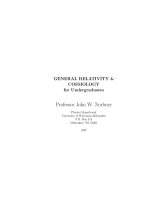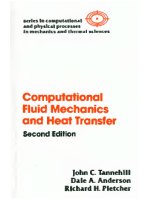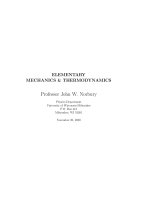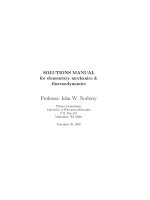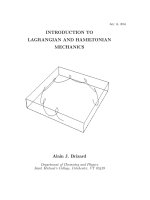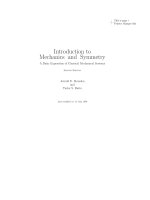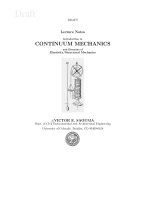- Trang chủ >>
- Khoa Học Tự Nhiên >>
- Vật lý
Elementary mechanics and thermodynamics j norbury
Bạn đang xem bản rút gọn của tài liệu. Xem và tải ngay bản đầy đủ của tài liệu tại đây (1.18 MB, 257 trang )
ELEMENTARY
MECHANICS & THERMODYNAMICS
Professor John W. Norbury
Physics Department
University of Wisconsin-Milwaukee
P.O. Box 413
Milwaukee, WI 53201
November 20, 2000
2
Contents
1 MOTION ALONG A STRAIGHT LINE 11
1.1 Motion 12
1.2 Position and Displacement 12
1.3 Average Velocity and Average Speed 14
1.4 Instantaneous Velocity and Speed 17
1.5 Acceleration 18
1.6 Constant Acceleration: A Special Case 20
1.7 Another Look at Constant Acceleration 23
1.8 Free-Fall Acceleration 24
1.9 Problems 28
2 VECTORS 31
2.1 Vectors and Scalars 32
2.2 Adding Vectors: Graphical Method 33
2.3 Vectors and Their Components 34
2.3.1 Review of Trigonometry 34
2.3.2 Components of Vectors 37
2.4 Unit Vectors 39
2.5 Adding Vectors by Components 41
2.6 Vectors and the Laws of Physics 43
2.7 Multiplying Vectors 43
2.7.1 The Scalar Product
(often called dot product) 43
2.7.2 The Vector Product 45
2.8 Problems 46
3 MOTION IN2&3DIMENSIONS 47
3.1 Moving in Two or Three Dimensions 48
3.2 Position and Displacement 48
3.3 Velocity and Average Velocity 48
3
4 CONTENTS
3.4 Acceleration and Average Acceleration 49
3.5 Projectile Motion 51
3.6 Projectile Motion Analyzed 52
3.7 Uniform Circular Motion 58
3.8 Problems 61
4 FORCE & MOTION - I 65
4.1 What Causes an Acceleration? 66
4.2 Newton’s First Law 66
4.3 Force 66
4.4 Mass 66
4.5 Newton’s Second Law 66
4.6 Some Particular Forces 67
4.7 Newton’s Third Law 68
4.8 Applying Newton’s Laws 69
4.9 Problems 77
5 FORCE & MOTION - II 79
5.1 Friction 80
5.2 Properties of Friction 80
5.3 Drag Force and Terminal Speed 82
5.4 Uniform Circular Motion 82
5.5 Problems 85
6 POTENTIAL ENERGY & CONSERVATION OF ENERGY 89
6.1 Work 90
6.2 Kinetic Energy 92
6.3 Work-Energy Theorem 96
6.4 Gravitational Potential Energy 98
6.5 Conservation of Energy 98
6.6 Spring Potential Energy 101
6.7 Appendix: alternative method to obtain potential energy . . 103
6.8 Problems 105
7 SYSTEMS OF PARTICLES 107
7.1 A Special Point 108
7.2 The Center of Mass 108
7.3 Newton’s Second Law for a System of Particles 114
7.4 Linear Momentum of a Point Particle 115
7.5 Linear Momentum of a System of Particles 115
CONTENTS 5
7.6 Conservation of Linear Momentum 116
7.7 Problems 118
8 COLLISIONS 119
8.1 What is a Collision? 120
8.2 Impulse and Linear Momentum 120
8.3 Elastic Collisions in 1-dimension 120
8.4 Inelastic Collisions in 1-dimension 123
8.5 Collisions in 2-dimensions 124
8.6 Reactions and Decay Processes 126
8.7 Problems 129
9 ROTATION 131
9.1 Translation and Rotation 132
9.2 The Rotational Variables 132
9.3 Are Angular Quantities Vectors? 134
9.4 Rotation with Constant Angular Acceleration 134
9.5 Relating the Linear and Angular Variables 134
9.6 Kinetic Energy of Rotation 135
9.7 Calculating the Rotational Inertia 136
9.8 Torque 140
9.9 Newton’s Second Law for Rotation 140
9.10 Work and Rotational Kinetic Energy 140
9.11 Problems 142
10 ROLLING, TORQUE & ANGULAR MOMENTUM 145
10.1 Rolling 146
10.2 Yo-Yo 147
10.3 Torque Revisited 148
10.4 Angular Momentum 148
10.5 Newton’s Second Law in Angular Form 148
10.6 Angular Momentum of a System of Particles 149
10.7 Angular Momentum of a Rigid Body Rotating About a Fixed
Axis 149
10.8 Conservation of Angular Momentum 149
10.9 Problems 152
11 GRAVITATION 153
11.1 The World and the Gravitational Force 158
11.2 Newton’s Law of Gravitation 158
6 CONTENTS
11.3 Gravitation and Principle of Superposition 158
11.4 Gravitation Near Earth’s Surface 159
11.5 Gravitation Inside Earth 161
11.6 Gravitational Potential Energy 163
11.7 Kepler’s Laws 170
11.8 Problems 174
12 OSCILLATIONS 175
12.1 Oscillations 176
12.2 Simple Harmonic Motion 176
12.3 Force Law for SHM 178
12.4 Energy in SHM 181
12.5 An Angular Simple Harmonic Oscillator 182
12.6 Pendulum 183
12.7 Problems 189
13 WAVES - I 191
13.1 Waves and Particles 192
13.2 Types of Waves 192
13.3 Transverse and Longitudinal Waves 192
13.4 Wavelength and Frequency 193
13.5 Speed of a Travelling Wave 194
13.6 Wave Speed on a String 196
13.7 Energy and Power of a Travelling String Wave 196
13.8 Principle of Superposition 196
13.9 Interference of Waves 196
13.10 Phasors 196
13.11 Standing Waves 197
13.12 Standing Waves and Resonance 197
13.13Problems 199
14 WAVES - II 201
14.1 Sound Waves 202
14.2 Speed of Sound 202
14.3 Travelling Sound Waves 202
14.4 Interference 202
14.5 Intensity and Sound Level 202
14.6 Sources of Musical Sound 203
14.7 Beats 204
14.8 Doppler Effect 205
CONTENTS 7
14.9 Problems 208
15 TEMPERATURE, HEAT & 1ST LAW OF THERMODY-
NAMICS 211
15.1 Thermodynamics 212
15.2 Zeroth Law of Thermodynamics 212
15.3 Measuring Temperature 212
15.4 Celsius, Farenheit and Kelvin Temperature Scales 212
15.5 Thermal Expansion 214
15.6 Temperature and Heat 215
15.7 The Absorption of Heat by Solids and Liquids 215
15.8 A Closer Look at Heat and Work 219
15.9 The First Law of Thermodynamics 220
15.10 Special Cases of 1st Law of Thermodynamics 221
15.11 Heat Transfer Mechanisms 222
15.12Problems 223
16 KINETIC THEORY OF GASES 225
16.1 A New Way to Look at Gases 226
16.2 Avagadro’s Number 226
16.3 Ideal Gases 226
16.4 Pressure, Temperature and RMS Speed 230
16.5 Translational Kinetic Energy 231
16.6 Mean Free Path 232
16.7 Distribution of Molecular Speeds 232
16.8 Problems 233
17 Review of Calculus 235
17.1 Derivative Equals Slope 235
17.1.1 Slope of a Straight Line 235
17.1.2 Slope of a Curve 236
17.1.3 Some Common Derivatives 239
17.1.4 Extremum Value of a Function 245
17.2 Integral 246
17.2.1 Integral Equals Antiderivative 246
17.2.2 Integral Equals Area Under Curve 247
17.2.3 Definite and Indefinite Integrals 249
17.3 Problems 255
8 CONTENTS
PREFACE
The reason for writing this book was due to the fact that modern intro-
ductory textbooks (not only in physics, but also mathematics, psychology,
chemistry) are simply not useful to either students or instructors. The typ-
ical freshman textbook in physics, and other fields, is over 1000 pages long,
with maybe 40 chapters and over 100 problems per chapter. This is overkill!
A typical semester is 15 weeks long, giving 30 weeks at best for a year long
course. At the fastest possible rate, we can ”cover” only one chapter per
week. For a year long course that is 30 chapters at best. Thus ten chapters
of the typical book are left out! 1500 pages divided by 30 weeks is about 50
pages per week. The typical text is quite densed mathematics and physics
and it’s simply impossible for a student to read all of this in the detail re-
quired. Also with 100 problems per chapter, it’s not possible for a student to
do 100 problems each week. Thus it is impossible for a student to fully read
and do all the problems in the standard introductory books. Thus these
books are not useful to students or instructors teaching the typical course!
In defense of the typical introductory textbook, I will say that their
content is usually excellent and very well writtten. They are certainly very
fine reference books, but I believe they are poor text books. Now I know
what publishers and authors say of these books. Students and instructors
are supposed to only cover a selection of the material. The books are written
so that an instructor can pick and choose the topics that are deemed best
for the course, and the same goes for the problems. However I object to
this. At the end of the typical course, students and instructors are left with
a feeling of incompleteness, having usually covered only about half of the
book and only about ten percent of the problems. I want a textbook that is
self contained. As an instructor, I want to be able to comfortably cover one
short chapter each week, and to have each student read the entire chapter
and do every problem. I want to say to the students at the beginning of
the course that they should read the entire book from cover to cover and do
every problem. If they have done that, they will have a good knowledge of
introductory physics.
This is why I have written this book. Actually it is based on the in-
troductory physics textbook by Halliday, Resnick and Walker [Fundamental
of Physics, 5th ed., by Halliday, Resnick and Walker, (Wiley, New York,
1997)], which is an outstanding introductory physics reference book. I had
been using that book in my course, but could not cover it all due to the
reasons listed above.
CONTENTS 9
Availability of this eBook
At the moment this book is freely available on the world wide web and
can be downloaded as a pdf file. The book is still in progress and will be
updated and improved from time to time.
10 CONTENTS
INTRODUCTION - What is Physics?
A good way to define physics is to use what philosophers call an ostensive
definition, i.e. a way of defining something by pointing out examples.
Physics studies the following general topics, such as:
Motion (this semester)
Thermodynamics (this semester)
Electricity and Magnetism
Optics and Lasers
Relativity
Quantum mechanics
Astronomy, Astrophysics and Cosmology
Nuclear Physics
Condensed Matter Physics
Atoms and Molecules
Biophysics
Solids, Liquids, Gases
Electronics
Geophysics
Acoustics
Elementary particles
Materials science
Thus physics is a very fundamental science which explores nature from
the scale of the tiniest particles to the behaviour of the universe and many
things in between. Most of the other sciences such as biology, chemistry,
geology, medicine rely heavily on techniques and ideas from physics. For
example, many of the diagnostic instruments used in medicine (MRI, x-ray)
were developed by physicists. All fields of technology and engineering are
very strongly based on physics principles. Much of the electronics and com-
puter industry is based on physics principles. Much of the communication
today occurs via fiber optical cables which were developed from studies in
physics. Also the World Wide Web was invented at the famous physics
laboratory called the European Center for Nuclear Research (CERN). Thus
anyone who plans to work in any sort of technical area needs to know the
basics of physics. This is what an introductory physics course is all about,
namely getting to know the basic principles upon which most of our modern
technological society is based.
Chapter 1
MOTION ALONG A
STRAIGHT LINE
SUGGESTED HOME EXPERIMENT:
Design a simple experiment which shows that objects of different weight
fall at the same rate if the effect of air resistance is eliminated.
THEMES:
1. DRIVING YOUR CAR.
2. DROPPING AN OBJECT.
11
12 CHAPTER 1. MOTION ALONG A STRAIGHT LINE
INTRODUCTION
:
There are two themes we will deal with in this chapter. They concern
DRIVING YOUR CAR and DROPPING AN OBJECT.
When you drive you car and go on a journey there are several things
you are interested in. Typically these are distance travelled and the speed
with which you travel. Often you want to know how long a journey will
take if you drive at a certain speed over a certain distance. Also you are
often interested in the acceleration of your car, especially for a very short
journey such as a little speed race with you and your friend. You want to
be able to accelerate quickly. In this chapter we will spend a lot of time
studying the concepts of distance, speed and acceleration.
LECTURE DEMONSTRATION:
1) Drop a ball and hold at different heights; it goes faster at bottom if
released from different heights
2) Drop a ball and a pen (different weights - weigh on balance and show
they are different weight); both hit the ground at the same time
Another item of interest is what happens when an object is dropped
from a certain height. If you drop a ball you know it starts off with zero
speed and ends up hitting the ground with a large speed. Actually, if you
think about it, that’s a pretty amazing phenomenom. WHY did the speed
of the ball increase ? You might say gravity. But what’s that ? The speed
of the ball increased, and therefore gravity provided an acceleration. But
how ? Why ? When ?
We shall address all of these deep questions in this chapter.
1.1 Motion
Read.
1.2 Position and Displacement
In 1-dimension, positions are measured along the x-axis with respect to some
origin.Itisuptoustodefine where to put the origin, because the x-axis is
just something we invented to put on top of, say a real landscape.
1.2. POSITION AND DISPLACEMENT 13
Example Chicago is 100 miles south of Milwaukee and Glendale
is 10 miles north of Milwaukee.
A. If we define the origin of the x-axis to be at Glendale what is
the position of someone in Chicago, Milwaukee and Glendale ?
B. If we define the origin of x-axis to be at Milwaukee, what is
the position of someone in Chicago, Milwaukee and Glendale ?
Solution
A. For someone in Chicago, x = 110 miles.
For someone in Milwaukee, x =10miles.
For someone in Glendale, x =0miles.
B. For someone in Chicago, x = 100 miles.
For someone in Milwaukee, x =0miles.
For someone in Glendale, x = −10 miles.
Displacement is defined as a change in position. Specifically,
∆x ≡ x
2
− x
1
(1.1)
Note: We always write ∆anything ≡ anthing
2
−anything
1
where anything
2
is the final value and anything
1
is the initial value. Sometimes you will
instead see it written as ∆anything ≡ anthing
f
− anything
i
where sub-
scripts f and i are used for the final and initial values instead of the 2 and
1 subscripts.
Example What is the displacement for someone driving from
Milwaukee to Chicago ? What is the distance ?
Solution
With the origin at Milwaukee, then the initial position
is x
1
=0miles and the final position is x
2
= 100 miles, so that
∆x = x
2
− x
1
= 100 miles. You get the same answer with the
origin defined at Gendale. Try it.
The distance is also 100 miles.
14 CHAPTER 1. MOTION ALONG A STRAIGHT LINE
Example What is the displacement for someone driving from
Milwaukee to Chicago and back ? What is the distance ?
Solution
With the origin at Milwaukee, then the initial position
is x
1
=0miles and the final position is also x
2
=0miles,so
that ∆x = x
2
− x
1
=0miles. Thus there is no displacement if
the beginning and end points are the same. You get the same
answer with the origin defined at Gendale. Try it.
The distance is 200 miles.
Note that the distance is what the odometer on your car reads. The
odometer does not read displacement (except if displacment and distance
are the same, as is the case for a one way straight line journey).
Do Checkpoint 1 [from Halliday].
1.3 Average Velocity and Average Speed
Average velocity is defined as the ratio of displacement divided by the corre-
sponding time interval.
¯v ≡
∆x
∆t
=
x
2
− x
1
t
2
− t
1
(1.2)
whereas average speed is just the total distance divided by the time interval,
¯s ≡
total distance
∆t
(1.3)
1.3. AVERAGE VELOCITY AND AVERAGE SPEED 15
Example What is the average velocity and averge speed for
someone driving from Milwaukee to Chicago who takes 2 hours
for the journey ?
Solution
∆x = 100 miles and ∆t =2hours, giving ¯v =
100 miles
2 hours
=
50
miles
hour
≡ 50 miles per hour ≡ 50 mph.
Note that the unit
miles
hour
has been re-written as miles per hour.
This is standard. We can always write any fraction
a
b
as a per b.
The word per just means divide.
The average speed is the same as average velocity in this case
because the total distance is the same as the displacement. Thus
¯s =50mph.
Example What is the average velocity and averge speed for
someone driving from Milwaukee to Chicago and back to Mil-
waukee who takes 4 hours for the journey ?
Solution
∆x =0miles and ∆t =2hours, giving ¯v =0!
However the total distance is 200 miles completed in 4 hours
giving ¯s =
200 miles
4 hours
=50mph again.
16 CHAPTER 1. MOTION ALONG A STRAIGHT LINE
A very important thing to understand is how to read graphs of position
and time and graphs of velocity and time, and how to interpret such graphs.
It is very important to understand how the average velocity is
obtained from a position-time graph. See Fig. 2-4 in Halliday.
LECTURE DEMONSTRATION:
1) Air track glider standing still
2) Air track glider moving at constant speed.
Let’s plot an x, t and v, t graph for
1) Object standing still,
2) Object at constant speed.
Note that the v, t graph is the slope of the x, t graph.
t
x
t
v
t
t
x
t
v
t
(A)
(B)
FIGURE 2.1 Position - time and Velocity - time graphs for A) object
standing still and B) object moving at constant speed.
Careully study Sample Problems 2-1, 2-2, Checkpoint 2 and
Sample Problem 2-3. [from Halliday]
1.4. INSTANTANEOUS VELOCITY AND SPEED 17
1.4 Instantaneous Velocity and Speed
When you drive to Chicago with an average velocity of 50 mph you probably
don’t drive at this velocity the whole way. Sometimes you might pass a truck
and drive at 70 mph and when you get stuck in the traffic jams you might
only drive at 20 mph.
Now when the police use their radar gun and clock you at 70 mph,you
might legitimately protest to the officer that your average velocity for the
whole trip was only 50 mph and therefore you don’t deserve a speeding
ticket. However, as we all know police officers don’t care about average ve-
locity or average speed. They only care about your speed at the instant that
you pass them. Thus let’s introduce the concept of instantaneous velocity
and instantaneous speed.
What is an instant ? It is nothing more than an extremely short time
interval. The way to describe this mathematically is to say that an instant
is when the time interval ∆t approaches zero, or the limit of ∆t as ∆t → 0
(approaches zero). We denote such a tiny time interval as dt instead of ∆t.
The corresponding distance that we travel over that tiny time interval will
also be tiny and we denote that as dx instead of ∆x.
Thus instantaneous velocity or just velocity is defined as
v = lim
∆t→0
∆x
∆t
=
dx
dt
(1.4)
Now such a fraction of one tiny dx divided by a tiny dt has a special name.
It is called the derivative of x with respect to t.
The instantaneous speed
or just speed is defined as simply the
magnitude of the instantaneous veloctiy
or magnitude of velocity.
Carefully study Sample Problem 2-4 [from Halliday].
18 CHAPTER 1. MOTION ALONG A STRAIGHT LINE
1.5 Acceleration
We have seen that velocity tells us how quickly position changes. Accelera-
tion tells us how much velocity changes. The average acceleration is defined
as
¯a =
v
2
− v
1
t
2
− t
1
=
∆v
∆t
and the instantaneous acceleration or just acceleration is defined as
a =
dv
dt
Now because v =
dx
dt
we can write a =
d
dt
v =
d
dt
dx
dt
which is often written
instead as
d
dt
dx
dt
≡
d
2
x
dt
2
, that is the second derivative of position with
respect to time.
Example When driving your car, what is your average acceler-
ation if you are able to reach 20 mph from rest in 5 seconds ?
Solution
v
2
= 20 mph v
1
=0
t
2
= 5 seconds t
1
=0
¯a =
20 mph − 0
5 sec − 0
=
20 miles per hour
5 seconds
=4
miles
hour seconds
=4mph per sec
=4
miles
hour
1
3600
hour
=14, 400 miles per hour
2
1.5. ACCELERATION 19
LECTURE DEMONSTRATION (previous demo continued):
1) Air track glider standing still
2) Air track glider moving at constant speed.
Now let’s also plot an a, t graph for
1) Object standing still,
2) Object at constant speed.
Note that the the a, t graph is the slope of the v,t graph.
t
a
t
(A)
t
a
t
(B)
FIGURE 2.2 Acceleration-time graphs for motion depicted in Fig. 2.1.
20 CHAPTER 1. MOTION ALONG A STRAIGHT LINE
1.6 Constant Acceleration: A Special Case
Velocity describes changing position and acceleration describes changing ve-
locity. A quantity called jerk describes changing acceleration. However, very
often the acceleration is constant, and we don’t consider jerk. When driving
your car the acceleration is usually constant when you speed up or slow
down or put on the brakes. (When you slow down or put on the brakes the
acceleration is constant but negative and is called deceleration.) When you
drop an object and it falls to the ground it also has a constant acceleration.
When the acceleration is constant, then we can derive 5 very handy
equations that will tell us everything about the motion. Let’s derive them
and then study some examples.
We are going to use the following symbols:
t
1
≡ 0
t
2
≡ t
x
1
≡ x
0
x
2
≡ x
v
1
≡ v
0
v
2
≡ v
and acceleration a is a constant and so a
1
= a
2
= a. Thus now
∆t = t
2
− t
1
= t − 0=t
∆x = x
2
− x
1
= x − x
0
∆v = v
2
− v
1
= v −v
0
∆a = a
2
− a
1
= a − a =0
(∆a must be zero because we are only considering constant a.)
Also, because acceleration is constant then average acceleration is always
the same as instantaneous acceleration
¯a = a
Now use the definition of average acceleration
¯a = a =
∆v
∆t
=
v −v
0
t − 0
=
v −v
0
t
Thus
at = v −v
0
or
1.6. CONSTANT ACCELERATION: A SPECIAL CASE 21
v = v
0
+ at
(1.5)
which is the first of our constant acceleration equations. If you plot this on
a v, t graph, then it is a straight line for a = constant. In that case the
average velocity is
¯v =
1
2
(v + v
0
)
From the definition of average velocity
¯v =
∆x
∆t
=
x − x
0
t
we have
x − x
0
t
=
1
2
(v + v
0
)
=
1
2
(v
0
+ at + v
0
)
giving
x − x
0
= v
0
t +
1
2
at
2
(1.6)
which is the second of our constant acceleration equations. To get the other
three constant acceleration equations, we just combine the first two.
22 CHAPTER 1. MOTION ALONG A STRAIGHT LINE
Example Prove that v
2
= v
2
0
+2a(x − x
0
)
Solution Obviously t has been eliminated. From (1.5)
t =
v −v
0
a
Substituting into (1.6) gives
x − x
0
= v
0
v −v
0
a
+
1
2
a
v −v
0
a
2
a(x − x
0
)=v
0
v −v
2
0
+
1
2
(v
2
− 2vv
0
+ v
2
0
)
= v
2
− v
2
0
or
v
2
= v
2
0
+2a(x − x
0
)
Example Prove that x − x
0
=
1
2
(v
0
+ v)t
Solution Obviously a has been eliminated. From (1.5)
a =
v −v
0
t
Substituting into (1.6) gives
x − x
0
= v
0
t +
1
2
v −v
0
t
t
2
= v
0
t +
1
2
(vt − v
0
t)
=
1
2
(v
0
+ v)t
Exercise Prove that x − x
0
= vt −
1
2
at
2
carefully study Sample Problem 2.8 [from Halliday]
1.7. ANOTHER LOOK AT CONSTANT ACCELERATION 23
1.7 Another Look at Constant Acceleration
(This section is only for students who have studied integral calculus.)
The constant acceleration equations can be derived from integral calculus
as follows.
For constant acceleration a = a(x), a = a(t)
a =
dv
dt
t
2
t
1
adt=
dv
dt
dt
a
t
2
t
1
dt =
v
2
v
1
dv
a(t
2
− t
1
)=v
2
− v
1
a(t − 0) = v −v
0
v = v
0
+ at
v =
dx
dt
vdt=
dx
dt
dt
v changes
.
cannot take outside integral
actually v(t)=v
0
+ at
t
2
t
1
(v
0
+ at)dt =
x
2
x
1
dx
v
0
t +
1
2
at
2
t
2
t
1
= x
2
− x
1
= v
0
(t
2
− t
1
)+
1
2
a(t
2
− t
1
)
2
= x − x
0
= v
0
(t − 0) +
1
2
a(t − 0)
2
= v
0
t +
1
2
at
2
.
x − x
0
= v
0
t +
1
2
at
2
a =
dv
dt
=
dv
dx
dx
dt
= v
dv
dx
24 CHAPTER 1. MOTION ALONG A STRAIGHT LINE
x
2
x
1
adx=
v
dv
dx
dx
a
x
2
x
1
dx =
v
2
v
1
vdv
a(x
2
− x
1
)=
1
2
v
2
v
2
v
1
=
1
2
v
2
2
− v
2
1
a(x − x
0
)=
1
2
v
2
− v
2
0
v
2
= v
2
0
+2a(x − x
0
)
One can now get the other equations using algebra.
1.8 Free-Fall Acceleration
If we neglect air resistance, then all falling objects have same acceleration
a = −g = −9.8 m/sec
2
(g = 9.8 m/sec
2
).
LECTURE DEMONSTRATION:
1) Feather and penny in vacuum tube
2) Drop a cup filled with water which has a hole in the bottom. Water
leaks out if the cup is held stationary. Water does not leak out if the cup is
dropped.
1.8. FREE-FALL ACCELERATION 25
Carefully study Sample Problems 2-9, 2-10, 2-11. [from Halliday]
Example I drop a ball from a height H, with what speed does
it hit the ground ? Check that the units are correct.
Solution
v
2
= v
2
0
+2a(x − x
0
)
v
0
=0
a = −g = −9.8 m/sec
2
x
0
=0
x = H
v
2
=0− 2 × g (0 −−H)
v =
2gH
Check units
:
The units of g are m sec
−2
and H is in m.Thus
√
2gH has units
of
√
m sec
−2
m =
√
m
2
sec
−2
= m sec
−1
. which is the correct
unit for speed.


